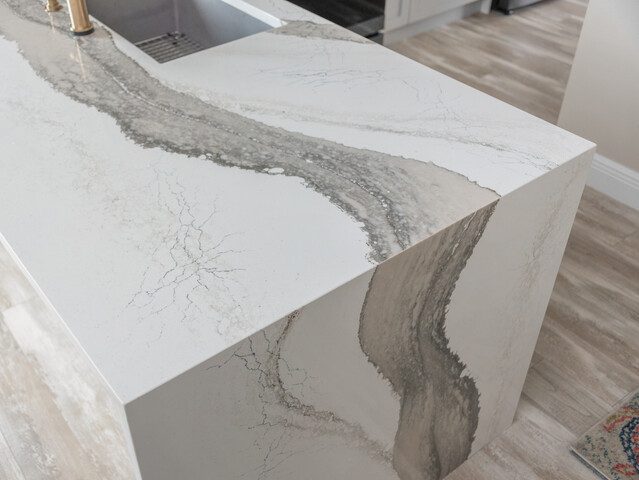If you are planning a kitchen remodel, you are probably looking at different countertop materials and trying to figure out which is best for you. Choosing the right countertop material is just as important as choosing the right layout or color scheme. Whether you're in Tampa, Orlando, Sarasota, Palm Harbor, Melbourne or beyond, homeowners are looking for a balance of style, durability, and value.
To help you decide, our remodeling designers put together a quick guide to the top countertop materials we recommend most—and why local homeowners love them.
1. Quartz: A Low-Maintenance Favorite
Quartz isn't mined from the earth, it's engineered for performance and style. You get consistent color, exceptional durability, beautiful aesthetics and no sealing is required. It’s ideal for Tampa and Orlando homes where heat, humidity, and a busy lifestyle call for a countertop that’s easy to care for.
Why Homeowners Love It:
- Stain, scratch, and chip-resistant.
- Tons of styles to choose from - ultra-modern to faux-marble looks.
- Predictable in terms of finishes, so no surprises.
- Non-porous and hygienic = No worries about mold or bacteria
Potential Cons: Quartz can’t quite replicate the depth of real marble. And while it’s extremely durable, it’s not invincible—excessive heat or hard impacts can still cause damage.
2. Quartzite: Natural and Durable
For a natural stone option, consider quartzite. Though typically more cost up front, it's natural beauty and durability is a great option for a luxury home.
Why Our Clients Love It:
- Quartzite is a natural stone with soft veining and elegant movement—often mistaken for marble but with more durability.
- Resistant to scratching and heat, making it great for busy kitchens.
- Won’t fade in direct sunlight—ideal for bright Florida homes or outdoor kitchens.
- Each slab is one-of-a-kind. You get the beauty of natural stone with distinct veining, movement, and color variations.
- Quartzite has a high-end look that can elevate the overall feel of your kitchen or bathroom.
Potential Cons: Unlike quartz (which is man-made), quartzite is porous and needs to be sealed regularly to prevent staining. The color range is mostly limited to white, gray, or beige tones. Potential for etching from acidic substances. Can be more expensive.
3. Marble: Elegant, Romantic & Upscale
Marble is what you choose when you want your kitchen remodel to be elegant and custom. Think soft veining, dramatic slabs, and a natural elegance that ages with grace. But, make no mistake about it, this stone is not low maintenance. And that’s perfectly fine—as long as you know what you’re signing up for.
From Hyde Park, Lakewood Ranch, Lake Nona to Winter Park, we’ve installed marble countertops for homeowners who love a sophisticated, timeless look. It’s perfect for master baths or statement kitchen islands.
Why Our Clients Love it:
- You want a unique, one-of-a-kind look (no two marble slabs the same).
- You’re okay with a little patina over time.
- You love the character that comes with natural stone.
- You’re designing for forever, not resale.
- You're designing a kitchen for aesthetics, not regular use
Potential Cons: marble scratches and etches more easily than quartz, especially with acids like lemon juice or vinegar. It is also easy to stain requiring regular sealing. If you cook a lot, entertain often, or want something totally worry-free, this might not be the best match.
4. Butcher Block: Natural, Cozy & Organic
For homes with a coastal or farmhouse vibe, butcher block brings warmth and texture to kitchens.
Why Our Clients Choose it:
- Softens a modern kitchen with a cozy, organic vibe
- Great for beachy or bungalow-style homes
- Perfect for kitchen islands or prep stations
- It's easy to refinish - you can sand it down and re-oil or reseal for a like-new look.
- It's sustainable and a great eco-friendly option when sourced from reclaimed or responsibly harvested wood.
Potential Cons: It does need maintenance such as oiling and sealing to protect from water damage and stains. It's not heat resistant so you can’t place hot pans directly on it—use trivets to avoid burn marks. While part of the charm for some, it does scratch easily so if you want a perfectly pristine look, this is not the material for you.
5. Porcelain: The Modern Marvel
Porcelain is making waves in newer Tampa and Orlando homes and condos. Its heat resistance and sleek look make it a smart pick—especially for indoor-outdoor kitchens.
Why Our Clients Love it:
- It's very durable. Fired at high temperatures, porcelain is resistant to scratches, chips, heat, and UV rays. Great for both indoor and outdoor kitchens.
- Non-porous and easy to clean—no sealing required. Won’t absorb stains, odors, or bacteria.
- Available in a wide range of colors and patterns, including realistic marble, stone, or concrete looks—with a sleek, modern finish.
- UV Resistant - Won’t fade in sunlight, making it ideal for Orlando and Tampa outdoor kitchens, lanais, or sun-drenched interiors.
Potential Cons:
While the surface is hard, the edges can be more fragile and prone to chips—especially if not installed properly. If a slab chips or cracks, repairs aren’t easy. Replacement may be necessary for significant damage. It has limited thickness options - Its thin profile may not suit every design aesthetic, especially in traditional or farmhouse-style kitchens.
6. Granite: Natural Beauty That Lasts
Granite continues to be a favorite in Orlando and Tampa homes for its natural stone charm and one-of-a-kind patterns. It fits beautifully in traditional, Mediterranean, or transitional homes throughout the Bay area.
Why Homeowners Love It:
- Lots of options when it comes to colors and patterns
- Granite is a very hard and durable material, resistant to scratches and heat.
- While naturally porous, granite can be sealed to effectively resist stains from spills.
- Granite can withstand high temperatures, though prolonged exposure to extreme heat can cause damage.
Designer Tip: Go with a lighter granite to keep your space feeling open and airy—especially if you’re working with limited natural light. More traditional granite designs work well if you are designing traditional or rustic-style kitchen.
Final Thoughts
Choosing the right countertop depends on your style, your lifestyle, and your long-term goals. Our Tampa and Orlando remodeling experts are here to guide you through the selection process and help you bring your vision to life.
Ready to explore your options? Visit one of our 7 showrooms in Central Florida or schedule a free in-home consultation today!

